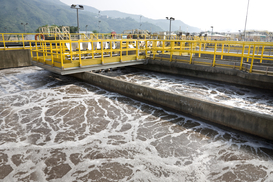
Here is how I evaluate the various options:
- Equilization - a common strategy available then when there is lagoon space or in rare cases, tank space. You can use equilization to slowly ramp up the flows and allow the biomass to grow in response to the higher loadings. Often aeration/mixing of the EQ basin is required to prevent odors.
- Existing buffering capacity - activated sludge systems have an adsorption capability where the MLSS acts like a sponge to hold excess organics. This increases sludge volumes going to the digester or dewatering, but it gives a buffer to increases in influent loadings. To best utilize this strategy, operators will increase MLSS/MLVSS before the seasonal loading. Limits to MLSS building are governed by system solids capacity (clarifier, aeration, etc) and the presence of influent organics to maintain a higher, active MLSS.
- Bioaugmentation - when a system requires a rapid increase in active biomass, the quickest way to bring about the change is to add "exogenous cultures" or "bugs". The preserved cultures are highly concentrated and usually consist of k-rate strategists (fast growing microbes). This helps to prevent effluent permit issues by rapidly increasing the viable portion of the MLSS.
- Polymer or other chemical addition - polymers to control biological solids and remove influent organics in primary treatment offers a very powerful control tool. Key issues to consider are correct polymer chemistry for the waste stream, dosing points for maximum effectiveness, and the impact on downstream solids handling.

 RSS Feed
RSS Feed